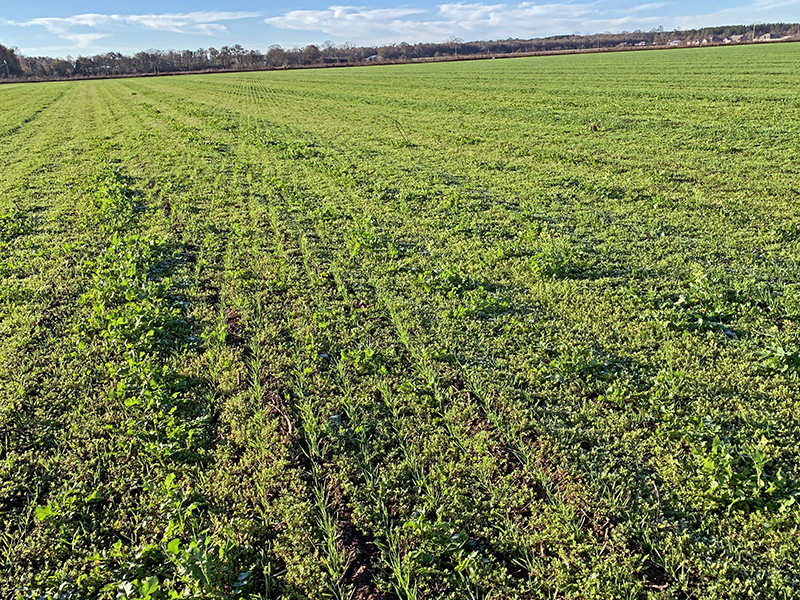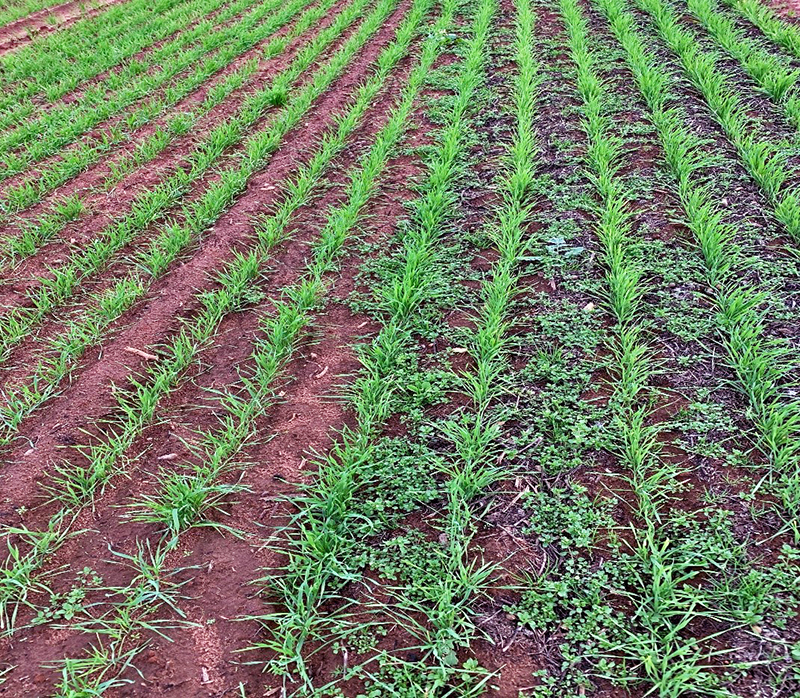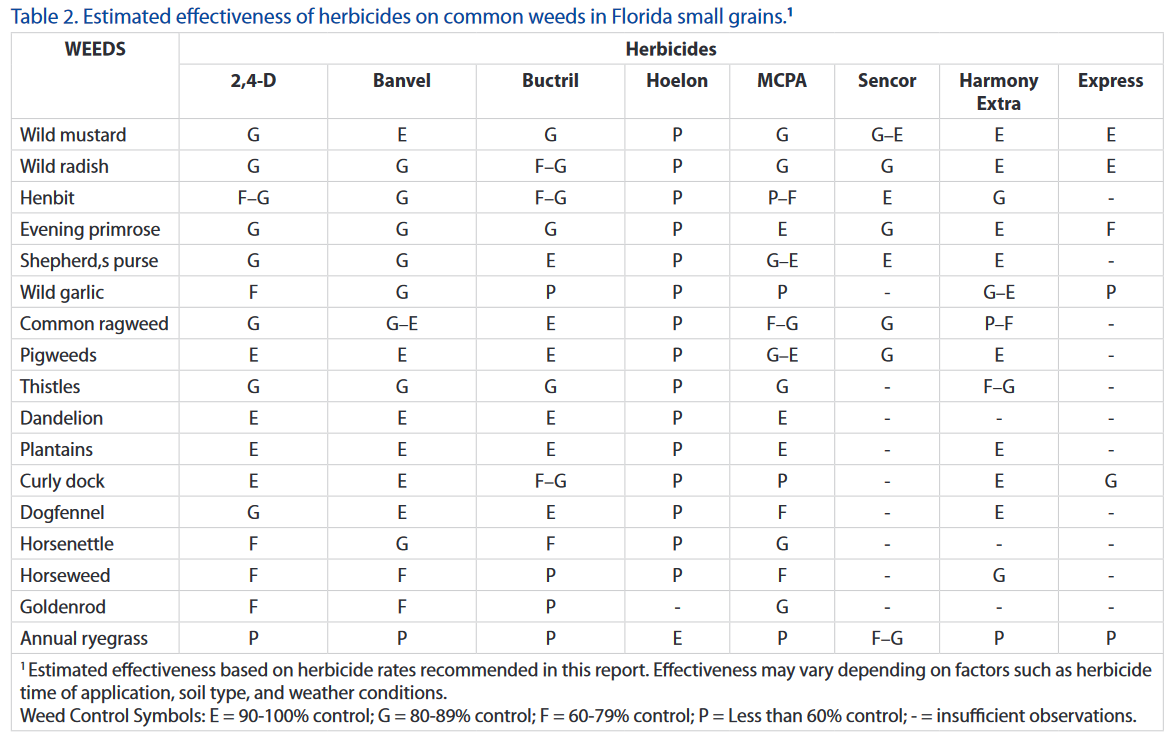
Keeping small grains weed-free for 6 to 8 weeks after planting is critical for preventing yield loss from weed competition The oats in this field in Santa Rosa County have so much weed competition that their performance has already been interfered with. Credit: Pratap Devkota, UF/IFAS
Pratap Devkota, Weed Scientist, UF/IFAS West Florida Research and Education Center, Jay, FL
–
For small grain crops (wheat, oats, rye, barley, triticale etc.), the first 6 to 8 weeks after planting are a critical growth period, so it is important to minimize weed competition. During the early stages, weed interference can be a serious problem for small grain crops. In our region, winter annual weeds such as henbit, chickweed, wild radish, wild mustard, cutleaf evening-primrose, shepherd’s-purse, annual bluegrass, and annual ryegrass are the major problematic weeds for small grain crop systems. If effective control measures are not implemented in time, weeds can not only reduce grain yield and quality, they can also interfere with the harvest.
Like any other crop, good cultural practices are vital for implementing weed management strategies successfully. Cultural practices such as seeding rate, row spacing, and time of planting need to be adjusted accordingly to favor the crop growth. Sound cultural practices enhance the competitive advantage of the crop over weeds. An early emerged, healthy, and uniform crop stand is very important for overall weed control program. Good crop stands with faster growth can cover the row-middle earlier shading the soil surface in a shorter period. The faster the shading or canopy closure by crop results in more suppression of weed emergence and growth.

The early emerging weeds in this wheat field in Santa Rosa County can easily be controlled with herbicides, before they make much of an impact on the growth of the crop. Credit: Pratap Devkota, UF/IFAS
–
Information on the weed species present, appropriate herbicide product and rate, and crop/weed growth stage are all extremely important factors to consider before selecting the best chemical weed control option in small grains. A good rule of thumb is to apply herbicide to small weeds (3 to 4 inches tall), unless specifically stated on label or recommendations. Even though most of the small grain crop herbicides are labeled for application up to the jointing and booting stage, weeds can get too large for complete control, if you wait too long. The most widely used herbicides in small grain crops are products containing 2,4-D, dicamba, or MCPA. These herbicides belong to the organo-auxin herbicide group and have potential for off-target movement. The label instructions and precautions should be read and followed carefully, with special attention given to avoid spray drift on sensitive crops. It is also very important to note that small grains vary in their tolerance to 2,4-D, depending upon the crop varieties and growth stage during herbicide application. Generally, wheat varieties are the most tolerant, barley is intermediate, and oats are least tolerant to 2,4-D. Rye is intermediate between wheat and barley.
–
Herbicide Options
The following are some herbicide product options for weed control in small grains (Please refer to specific herbicide product labels for detailed information). The efficacy chart that follows provides recommendations for specific weed species.
- Clarity and others (dicamba): Effective on annual broadleaf weeds, apply when weeds are at the 2-3 leaf stage and rosettes are less than 2 inches in diameter. Apply after crop is 3-4 tiller stage, but before the jointing stage. The highest level of weed control is achieved while temperatures are above 60° F.
- 2,4-D products (2,4-D): Products are available in either ester or amine formulations. Ester formulations have higher volatility, while amine formulations have lower efficacy in cold weather. 2,4-D products are effective in controlling broadleaf weeds, and wild garlic or onion. Apply after the crop has produced 4 tillers and up to full tiller stage (do not apply during jointing stage). The highest level of weed control is achieved while temperature is above 60° F.
- Buctril 4 EC (bromoxynil): Provides good control of wild radish and small seeded broadleaf weeds. Apply POST when weeds are up to 3-4 leaf stage. Do not apply to small grain crops during or after the booting stage.
- Harmony Extra (thifensulfuron + tribenuron): Provides POST control of broadleaf weeds (particularly wild radish) in wheat. Wild radish rosettes should be less than 6″ in diameter.
- Huskie (bromoxynil+pyrasulfotole): Controls broadleaf weeds in wheat, rye, and triticale. Apply when crop is at the 1-leaf stage until flag leaf stage.
- Hoelon (diclofop-methyl): For annual ryegrass control in wheat. Annual ryegrass weeds should be smaller than 5 leaf stage. Apply on wheat crop before jointing stage. Can be tank-mixed with Buctril for broadleaf weed control.
- Metribuzin (metribuzin): Good option for controlling annual weeds such as henbit, chickweed, ryegrass, and some other species on barley and wheat. Apply after the crop has reached the 2-leaf stage, but before the jointing stage.
- MCPA and several products (MCPA): Recommended for weed control in wheat, rye, oats, and barley. Apply after 2-tillers, but before the jointing stage. Weeds need to be less than 2” in height or diameter.

Source: Weed Management in Small Grains Harvested for Grain SS-AGR-07
–
Herbicide Performance Issue During Cold Weather:
Most of the herbicide applications for small grain crops occur during the winter months. Some information on the effect of cold temperatures on herbicide efficacy might be helpful in considering spray application at the appropriate temperature range for improving weed control from herbicide applications.
- The optimum temperature range for POST herbicides is 60° to 85° F. If the daytime temperature is below 60° F (or nighttime temperature is below 40° F), herbicides kill weeds slower than at the optimum temperature range. Systemic herbicides such as 2,4-D, dicamba, MCPA, Roundup, and Stinger provide reduced or slower weed control response during cold temperatures, because weeds are not actively absorbing and transporting herbicides in their system.
- Weed control can be reduced during low temperatures, this is particularly true for the contact herbicides, such as Buctril, Lactofen, Gramoxone, Liberty etc. These products provide lower control during cold temperatures, because the cell walls of weeds are hardened, and the wax cuticle on the leaf can be thicker on plants growing at colder temperatures.
- The potential for crop injury increases with the cold temperatures, because the herbicide remains in the plant system for a longer duration. Herbicides do not get broken down as quickly in the plant system during cold temperatures. Herbicides from Group #2 (ALS Inhibitors) have a higher potential to cause injury during cold temperatures.
- To mitigate effect of cold temperatures on herbicide efficacy, consider spraying herbicides when daytime temperature is above 60° F.
–
